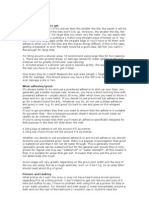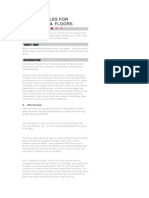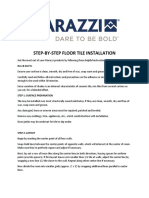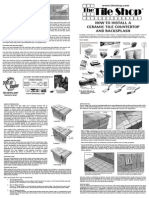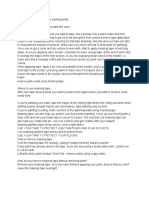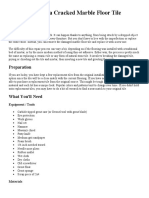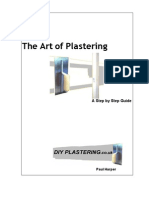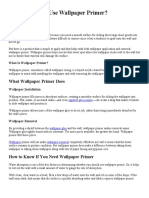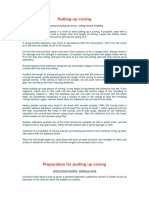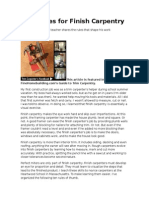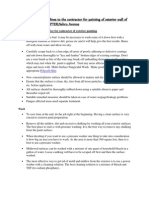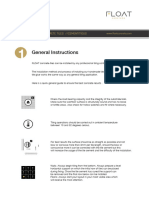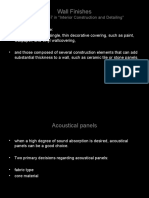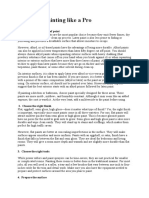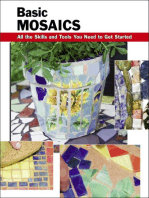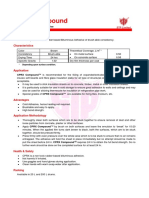Tips & Tricks: Wallcoverings For The Ultimate in Refinement
Tips & Tricks: Wallcoverings For The Ultimate in Refinement
Uploaded by
dajuhannaCopyright:
Available Formats
Tips & Tricks: Wallcoverings For The Ultimate in Refinement
Tips & Tricks: Wallcoverings For The Ultimate in Refinement
Uploaded by
dajuhannaOriginal Description:
Original Title
Copyright
Available Formats
Share this document
Did you find this document useful?
Is this content inappropriate?
Copyright:
Available Formats
Tips & Tricks: Wallcoverings For The Ultimate in Refinement
Tips & Tricks: Wallcoverings For The Ultimate in Refinement
Uploaded by
dajuhannaCopyright:
Available Formats
wallcoverings for the ultimate in refinement
Tips & tricks
Wallcoverings
- Always check that the rolls have the same batch number and check the rolls for defects. If rolls with a
different manufacturing number are mixed up together, you may end up with colour inconsistencies. In
some cases, we even recommend not using rolls from different boxes on the same area.
- When using a yardage product, the lengths must be cut and applied in succession. Different rolls of
wallcovering when cut off (even if they have the same batch number) should not be mixed on the same
wall.
- Always follow the instructions that come with the wallcovering you have purchased. Remember that
even within the same collection, these instructions may vary from reference to reference.
- Seams will be less visible if you wallcovering from the main light source to the most important
direction of view. Even taking a break when working on a wall may lead to visible seams.
Surface
- Rust spots, grease, tar, pens, old synthetic or alcohol adhesives may show through the wallcovering. It is
essential to clean, remove or isolate them.
- A perpendicular line drawn with a pencil that was too soft or the chalk line may also show up in the
seam.
- If existing wallcovering cannot be removed from the wall, there is just one option left: carefully sand
all uneven spots and seams smooth, so that they will not show through the new wallcovering later. Make
sure that all loose parts and dust are removed.
- A porous or granular wall surface may absorb so much adhesive that it will not adhere properly.
Pre-paste walls like this beforehand with a slightly diluted adhesive (preparation ratios for pre-pasting
adhesives) and allow the wall to dry for at least a day. This will make the wall less absorbent. Gypsum
boards, chipboard and stucco must always be treated this way.
- An uneven surface may show through a thin and/or light coloured wallcovering. An even non-woven
lining (such as Teqno or Patent Vlies) may provide a solution. If the surface is painted in different shades,
chalky (cheap) masonry paint may solve the problem. Follow the paint manufacturers instructions
strictly, because not all types of paint and varnish are compatible.
- Pay enough attention to the surface. Satin glossy, even wallcovering in particular will show every
defect in the surface. In extreme cases, adhesive that has not dissolved fully can cause irregularities that
are visible in oblique light, so please be careful with wall lighting and spots.
www.arte-international.com
1/3
wallcoverings for the ultimate in refinement
- The cause of problems with damp must be known and solved before you can begin work.
- Dimensional stability is both an advantage and disadvantage in wallcovering. Large irregularities
(bumps or hollows) may be to blame for joints not fitting together seamlessly.
- Apply diluted wallcovering adhesive to places where the wall has been retouched one day before wall
papering. This will prevent the wallcovering from coming loose at these places.
- By using fillets (such as Profilo) at outer corners that are not completely straight (which is often the
case), you can avoid a seam that does not fit neatly with the next length. These fillets can usually be
painted over.
- Avoid droughts when wallpapering.
Adhesive
- For non-woven wallcoverings, use CLEARPRO adhesive from Arte.
- Powder adhesive must always be dissolved properly and free of lumps.
- Always follow the measurements stated on the packaging.
- The adhesive must always be spread evenly on the wall (or material). Oblique light can be a great help.
Pre-pasting walls to deal with irregular or excess absorption is not much effort when you consider the
extra work that cutting corners at this stage could cause later.
- Always brush/roll the wallcovering with vertical movements. Brushing it in a horizontal direction may
lead to the covering shifting or becoming broader. This may also move too much adhesive to the sides of
the length, resulting in adhesive stains or bulges.
Adhesive stains
- Adhesive stains must be removed as quickly as possible. The amount of water used to do this depends
on the top layer and water sensitivity of the wallpaper. Never remove dry adhesive stains.
- Adhesive stains on non-woven wallpapers can be washed off. With some collections, you must be
careful that the fabric does not roughen up or fray. This occurs when adhesive stains are too dry
and are removed too vigorously. Make the sponge wet enough and dry it carefully afterwards with a
microfiber cloth.
- Some references are practically unwashable, so that it is impossible to remove adhesive or other stains
without leaving a mark. When pressing on the seams in delicate wallpapers, you can use an absorbent
tissue paper or kitchen roll that can absorb excess adhesive directly at the seams.
Soaking time
- When working with dimensionally stable wallcoverings (paper or paper backed) you must always
respect the correct soaking time. This type of wallcovering expands when it is moist and shrinks during
the drying process. The strength of the adhesive and the condition of the surface must be good enough
to deal with this drying out tension.
- The soaking time is usually stated on the papering instructions.
- If the soaking time is not stated on the instructions, you can check how long it is. Paste a strip (or wet
it) and then see how long it takes to reach its maximum breadth.
- If it is soaked for too long, the edges (even if you have folded the length after pasting) will already be
drying and may even stick to each other.
- If the strip is not soaked for long enough, it will continue to expand on the wall and bubbles may
form. Lengths that are not soaked for long enough or for the same length of time may also prevent the
seams from fitting neatly together.
www.arte-international.com
2/3
wallcoverings for the ultimate in refinement
Hanging
- Complete each wall in succession. This prevents both seams and colour or structure inconsistencies
that may occur if, for example, the parts above windows and doors are papered later.
- Always cut wallcoverings at a recessed angle, but fold it over if there is a salient angle. Measure out the
plumb line again after each angle.
- Place large patterns in the wallcovering together in an unobtrusive corner.
- Begin wallpapering where the light enters, preferably as close as possible to the window. This reduces
the risk of visible seams caused by the incidence of light.
- Newly hung, damp wallcoverings are vulnerable. Wait with finishing and hanging decorations until
they are completely dry.
Use of materials
- Using the wrong materials to brush wallcovering can cause problems. With very fragile coverings, it
is better to use the rubber roller rather than a spatula.You will also need to take the necessary caution
when using a seam roller. The wrong seam roller (for example, a hard, bent and embossed seam roller)
may make imprints on the wallcovering or even on the surface.
- It is best to choose a smooth seam roller. A barrel shaped seam roller will always press the adhesive
away from the seam, while that is the place that requires the most adhesive to absorb shrinkage.
Sometimes, we would even recommend using a rubber seam roller.
Open seams
- Open seams may have various causes. They are often caused by a poor surface, such as poorly adhering
layers of paint plaster or lining paper. This can even lead to wallcovering coming loose months after it
was hung.
- A non-permeable surface, especially in combination with vinyl wall paper causes the adhesive to stay
wet for too long so that it is impossible for permanent adhesion with the surface to occur.
- Heating a room too soon after hanging (heaters, open hearths) but also halogen lamps placed too close
to a newly papered wall, can also cause too much shrinkage (especially with paper-backed vinyl).
- Open seams may also be caused by not having enough adhesive at the seams and adhesive that is not
strong enough.
www.arte-international.com
3/3
You might also like
- BS en 12004-1 2017Document38 pagesBS en 12004-1 2017spectrolabrourkelaNo ratings yet
- How To TileDocument17 pagesHow To TileAlan SonNo ratings yet
- Tiling BibleDocument8 pagesTiling BibleAdrian FavellNo ratings yet
- Artex and Plaster: 2 - Choosing The Right ProductDocument7 pagesArtex and Plaster: 2 - Choosing The Right ProductMladen MohrNo ratings yet
- Ceramic Tiles For WorktopsDocument7 pagesCeramic Tiles For WorktopseqdnaNo ratings yet
- Project Co-Ordination ExperienceDocument10 pagesProject Co-Ordination ExperienceHueyJenn TanNo ratings yet
- 20 Tiling Floors PDFDocument10 pages20 Tiling Floors PDFGopal SudhirNo ratings yet
- A Guide To Wall TilingDocument6 pagesA Guide To Wall Tilingkirina2840No ratings yet
- Wall Tiling PDFDocument7 pagesWall Tiling PDFHorace Prophetic Davis100% (1)
- Finishes Y3Document11 pagesFinishes Y3reaganpablo126No ratings yet
- How To Install Ceramic Wall TileDocument6 pagesHow To Install Ceramic Wall TileRi SovannaphumiNo ratings yet
- Paint Problems and Solutions - BrochureDocument16 pagesPaint Problems and Solutions - BrochureBrian ArmadoNo ratings yet
- Interior PaintingDocument8 pagesInterior PaintingbigvalleyNo ratings yet
- MZ Installing Tile WebDocument6 pagesMZ Installing Tile WebRi SovannaphumiNo ratings yet
- Back Splash InstallDocument2 pagesBack Splash InstallJames Green100% (1)
- PaintDocument27 pagesPaintLghbondNo ratings yet
- Downloads Wide Width FBDocument2 pagesDownloads Wide Width FBNaqsh MemonNo ratings yet
- Floating FloorDocument10 pagesFloating FloorIuliaNo ratings yet
- The Art of Gypsum PlasterDocument6 pagesThe Art of Gypsum PlasterashenafiiNo ratings yet
- Method of Installation: Wall Finishes Plaster and PaintingDocument12 pagesMethod of Installation: Wall Finishes Plaster and Paintingillya amyraNo ratings yet
- How To Install Marble Floor TilesDocument6 pagesHow To Install Marble Floor TilesRi SovannaphumiNo ratings yet
- How To Use Masking Tape For Painting WallsDocument2 pagesHow To Use Masking Tape For Painting WallsJoe BlackNo ratings yet
- How To Replace A Cracked Marble Floor TileDocument4 pagesHow To Replace A Cracked Marble Floor TileRi SovannaphumiNo ratings yet
- How To Install Slate TileDocument6 pagesHow To Install Slate TileRi SovannaphumiNo ratings yet
- Common Defects in PlasterDocument2 pagesCommon Defects in PlasterHatta RizqNo ratings yet
- Diy Tiling GuideDocument6 pagesDiy Tiling GuidenextreaderNo ratings yet
- How Is Bamboo Floor InstalledDocument4 pagesHow Is Bamboo Floor Installeddeboline mitraNo ratings yet
- How To Install Slate TileDocument6 pagesHow To Install Slate TileRi SovannaphumiNo ratings yet
- Flooring VinylFlooring 20190514Document9 pagesFlooring VinylFlooring 20190514BeatrizLlamasNo ratings yet
- How To Install Marble Floor TilesDocument5 pagesHow To Install Marble Floor TilesRi SovannaphumiNo ratings yet
- How To Install Mosaic TileDocument5 pagesHow To Install Mosaic TileRi SovannaphumiNo ratings yet
- The Art of Plastering: A Step by Step GuideDocument29 pagesThe Art of Plastering: A Step by Step GuideAtis SivinsNo ratings yet
- Installatie Instructies en SMPDocument3 pagesInstallatie Instructies en SMPManvictNo ratings yet
- Tile Laying LeafletDocument1 pageTile Laying LeafletniroNo ratings yet
- Tiles SettingDocument41 pagesTiles Settingjadetacata001No ratings yet
- Do You Need To Use Wallpaper PrimerDocument3 pagesDo You Need To Use Wallpaper PrimerRi SovannaphumiNo ratings yet
- TB - Marmoleum Characteristics Installation ProblemsDocument8 pagesTB - Marmoleum Characteristics Installation ProblemsdoutorNo ratings yet
- Quick Guid Ceramic TileDocument84 pagesQuick Guid Ceramic Tilehelios888100% (1)
- Tileworks Fixing Guide V2 04 23 1Document28 pagesTileworks Fixing Guide V2 04 23 1Jonathan JaegerNo ratings yet
- Common Defects in PlasterDocument2 pagesCommon Defects in PlasterRm1262No ratings yet
- Installation Instructions: CeramicaDocument1 pageInstallation Instructions: CeramicarbskoveNo ratings yet
- Plastering ProcessDocument15 pagesPlastering ProcessPageduesca RouelNo ratings yet
- Ceramic Tile InstallationDocument4 pagesCeramic Tile InstallationAjit Singh RathoreNo ratings yet
- Process of Tile InstallationDocument39 pagesProcess of Tile InstallationChristian Nathaniel Ramon Palma100% (1)
- Cornices and Coving PDFDocument5 pagesCornices and Coving PDFGenesis PureNo ratings yet
- Carpet Installation Guide: HospitalityDocument10 pagesCarpet Installation Guide: HospitalityLe Ngoc AnhNo ratings yet
- Ten Rules For Finish CarpentryDocument12 pagesTen Rules For Finish Carpentryjosvelasco100% (1)
- Common Defects in PlasterDocument2 pagesCommon Defects in PlasterDesmond VlietstraNo ratings yet
- Plaster and Render - Autonopedia PDFDocument12 pagesPlaster and Render - Autonopedia PDFIgnacio Luis Reig MataixNo ratings yet
- Instructions and Guidelines To The Contractor For Painting of Exterior Wall of IEDocument8 pagesInstructions and Guidelines To The Contractor For Painting of Exterior Wall of IEhbgdiatmNo ratings yet
- Rubber Flooring Installation GuideDocument5 pagesRubber Flooring Installation GuidePista Cristiana-BeatriceNo ratings yet
- INSTALLGUIDE CementDocument6 pagesINSTALLGUIDE CementvelevveraNo ratings yet
- Presentation Wall FinDocument67 pagesPresentation Wall FinManju Navin KumarNo ratings yet
- 9 Steps To Painting Like A Pro: 1. Choose The Right Type of PaintDocument3 pages9 Steps To Painting Like A Pro: 1. Choose The Right Type of PaintHinda ZianiNo ratings yet
- How To Repair Cracks in Walls 2Document18 pagesHow To Repair Cracks in Walls 2Endale YimamNo ratings yet
- Winchester Fixing GuideDocument20 pagesWinchester Fixing Guideabdulsalam.oparindeNo ratings yet
- Painting Tips - Most Frequently Asked Questions: How Much Paint Do I Need?Document5 pagesPainting Tips - Most Frequently Asked Questions: How Much Paint Do I Need?expertmaxwell100% (1)
- How To Skim Coat WallsDocument7 pagesHow To Skim Coat Wallsbwatkins6No ratings yet
- Basic Mosaics: All the Skills and Tools You Need to Get StartedFrom EverandBasic Mosaics: All the Skills and Tools You Need to Get StartedRating: 2 out of 5 stars2/5 (1)
- Stamark Removable TapesDocument4 pagesStamark Removable TapesGoran KalamandaNo ratings yet
- Uk Aad Product Catalogue 2015 PDFDocument109 pagesUk Aad Product Catalogue 2015 PDFWOLFWBEARWNo ratings yet
- Research Proposal IV Grade IX Edit pt.3Document17 pagesResearch Proposal IV Grade IX Edit pt.3Briannah Yve PuntaNo ratings yet
- Crate & Barrel Knock Off BookcaseDocument8 pagesCrate & Barrel Knock Off BookcaseDittle Dattle100% (1)
- MC1500 Klej Cyjanoakrylowy (TDS)Document2 pagesMC1500 Klej Cyjanoakrylowy (TDS)Bakhtiyar PaizullayevNo ratings yet
- LOCTITE HY 4090 en - GLDocument4 pagesLOCTITE HY 4090 en - GLkhame006No ratings yet
- Waterleaks: Section: 9IDocument6 pagesWaterleaks: Section: 9IBlakess SpanNo ratings yet
- Bioflex 2015 IN - (EN) PDFDocument4 pagesBioflex 2015 IN - (EN) PDFBijaya RaulaNo ratings yet
- Epr 1Document10 pagesEpr 1RazvanAngheleNo ratings yet
- Polymer Coatings: Coating ProcessDocument3 pagesPolymer Coatings: Coating ProcesswaqasNo ratings yet
- BS en 1279-4-2002Document32 pagesBS en 1279-4-2002donalexx100% (1)
- Tesa® Spiralsleeve 51026 PV5: Product InformationDocument2 pagesTesa® Spiralsleeve 51026 PV5: Product InformationAtochkavNo ratings yet
- Dow Chemical. Materials Science Contributions To Membrane ProductionDocument39 pagesDow Chemical. Materials Science Contributions To Membrane ProductionJafar EhsaniNo ratings yet
- Ao InstrumentsDocument28 pagesAo InstrumentsnurheniNo ratings yet
- Permabond TA4610 (Adesivo para PET) - 2020Document2 pagesPermabond TA4610 (Adesivo para PET) - 2020Edson França RodriguesNo ratings yet
- CPRX Compound1Document2 pagesCPRX Compound1Sonu SimonNo ratings yet
- Devcon Catalog PDFDocument24 pagesDevcon Catalog PDFSergio MarchettiNo ratings yet
- Composites and Non MetallicsDocument112 pagesComposites and Non MetallicssreeramNo ratings yet
- Sae Ams3690d-2016Document7 pagesSae Ams3690d-2016Luis PaletoNo ratings yet
- Classic Flag Case: © 2014 August Home Publishing CoDocument11 pagesClassic Flag Case: © 2014 August Home Publishing Cokostas1977No ratings yet
- Syllabus CONSCHEM PasigSciDocument6 pagesSyllabus CONSCHEM PasigSciDon King EvangelistaNo ratings yet
- Loctite 7075 TdsDocument1 pageLoctite 7075 TdsSurajPachhadeNo ratings yet
- Roff Master Fix Adhesive Mfa Tds DownloadDocument5 pagesRoff Master Fix Adhesive Mfa Tds DownloadsanjayNo ratings yet
- Foster Adhesive: Technical Data SheetDocument2 pagesFoster Adhesive: Technical Data SheetMounir BoutaghaneNo ratings yet
- Building Fully Cored Rescue BoatsDocument12 pagesBuilding Fully Cored Rescue Boatsbrendanc55323100% (1)
- N-2000 Antimicrobial TDSDocument9 pagesN-2000 Antimicrobial TDSRonald Figo Torres EcheNo ratings yet
- Bison Panel Layout PDFDocument48 pagesBison Panel Layout PDFRohan Kulkarni100% (1)
- Loctite Catalogue 6023 AamDocument30 pagesLoctite Catalogue 6023 AamAndre FaccinNo ratings yet



